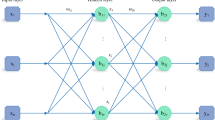Abstract
An intelligent security systems engineering approach is used to analyze fire and explosive critical incidents, a growing concern in urban communities. A feed-forward back-propagation neural network models the damages arising from these critical incidents. The overall goal is to promote fire safety and sustainable security. The intelligent security systems engineering prediction model uses a fully connected multilayer neural network and considers a number of factors related to the fire or explosive incident including the type of property affected, the time of day, and the ignition source. The network was trained on a large number of critical incident records reported in Toronto, Canada between 2000 and 2006. Our intelligent security systems engineering approach can help emergency responders by improving critical incident analysis, sustainable security, and fire risk management.
Similar content being viewed by others
References
Battiti, R. & Masulli, F. (1990). BFGS optimization for faster and automated supervised learning. In: Proceedings of the International Neural Network Conference, 757–760, Paris
Chen, K., Jacobson, C. & Blong, R. (2004). Artificial neural networks for risk decision support in natural hazards: a case study of assessing the probability of house survival from bushfires. Environmental Modeling and Assessment, 9(3): 189–199
Choudhury J.R., Banerjee T.P., Das S., Abraham A. & Snášel V. (2009). Fuzzy rule based intelligent security and fire detector system. Advances in Soft Computing, 63: 45–51
Council of Canadian Fire Marshals and Fire Commissioners (CCFM-FC). (2007). Fire losses in Canada. Annual Report 2002
Critical Incident Analysis Group (CIAG). (2009). University of Virginia. Available via DIALOG. http://www.healthsystem.virginia.edu/internet/ciag/
Gurney, K. (1997). An Introduction to Neural Networks. Routledge, London
Hagan, M.T. & Menhaj, M.B. (1994). Training feed forward network with the Marquardt algorithm. IEEE Trans. on Neural Net., 5(6): 989–993
Haykin, S. (1999). Neural Networks: A Comprehensive Foundation. Prentice Hall
Hornik, K. (1991). Approximation capabilities of multilayer feedforward networks. Neural Networks, 4(22): 251–257
Johansson, M., Dowla, F.U. & Goodman, D.M. (1991). Backpropagation learning for multilayer feed-forward neural networks using the conjugate gradient method. Int. J. Neural Syst., 2(4): 291–301
Lo, S.M., Liu, M. & Yuen, R.K.K. (2009). An artificial neural-network based predictive model for pre-evacuation human response in domestic building fire. Fire Technology, 45(4): 431–439
National Center for Critical Incident Analysis (NCCIA) (2009). National Defense University. Available via DIALOG. http://www.criticalincident.org/index.html
Nelson, M.M. & Illingworth, W.T. (1991). A Practical Guide to Neural Nets. Addison-Wesley, Reading, MA
Rose-Pehrsson, S.L., Hart, S.J., Street, T.T, Williams, F.W., Hammond, M.H., Gottuk, D.T., Wright, M.T. & Wong, J.T. (2003). Early warning fire detection system using a probabilistic neural network. Fire Technology, 39(2): 147–171
Rumelhart, D.E., Hinton, G.E. & Williams, R.J. (1986). Learning internal representations by error propagation. Parallel Data Processing, 1(8): 318–362
Suratgar, A.A., Tavakoli, M.B. & Hoseinabadi, A. (2005). Modified Levenberg-Marquardt method for neural networks training. Trans. Eng. Comput. Technol., 6: 46–48
Ung, S.T., Williams, V. & Bonsall, S. (2006). Test case based risk predictions using artificial neural network. Journal of Safety Research, 37(3): 245–260
Xia, D. (2007). Fire risk evaluation model of high-rise buildings based on multilevel BP neural network. In: Fourth International Conference on Fuzzy Systems and Knowledge Discovery (FSKD), Haikou, Hainan, China, 2007
Zurada, J. (1992). Introduction to Artificial Neural Systems. West Publishing Co., St. Paul, MN
Author information
Authors and Affiliations
Corresponding author
Additional information
Ali Asgary is an Associate Professor of Disaster and Emergency Management at the School of Administrative Studies at York University, Toronto, Ontario, Canada. He is also an adjunct professor at the Faculty of Geography at Tehran University, Tehran, IRAN. He received his BA and MA from the University of Tehran in Economic Theory and PhD. in Urban and Regional Planning from the School of Architecture, Planning and Landscape at the University of Newcastle upon Tyne, Newcastle, England (1996). He teaches advanced disaster and emergency management and business continuity management courses at the undergraduate and graduate levels. His areas of research include the development and application of GIS, Multi-Criteria Decision Support Systems, Intelligent Systems, and Virtual Worlds, with application to disaster and emergency management. He has been the principle investigator and co-investigator of several projects funded by NSERC (National Science and Engineering Research Council), SSHRC (Social Sciences and Humanities Research Council), and GEOIDE (Geomatics for Informed Decision Centre of Excellence).
Ali Sadeghi Naini received his B.Sc. degree in Computer Engineering (Software) from University of Isfahan, Isfahan, IRAN, and his M.Sc. degree with best honours in Computer Engineering (Artificial Intelligence) from Tehran Polytechnic University, Tehran, IRAN, in 2004 and 2006, respectively. He is currently a PhD. candidate in the Department of Electrical and Computer Engineering at the University of Western Ontario, London, Ontario, Canada.
Jason K. Levy is an Associate Professor in the Homeland Security and Emergency Preparedness program (L. Douglas Wilder School of Government and Public Affairs) at Virginia Commonwealth University (VCU). He currently serves as Director of the Systems Engineering and Global Policy Group and is also on the Graduate Faculty of the PhD program in Public Policy and Administration (at the VCU Center for Public Policy) His major research interests are the development of multiple objective decision making, geomatics, conflict resolution, and environmental modeling techniques from a systems engineering perspective with application to water resources management, air quality, and sustainability. He received his Bachelor’s, Master’s and PhD degrees in Systems Design Engineering from the University of Waterloo in 1994, 1996 and 2001, respectively. Dr. Levy is also an Adjunct Faculty in the Natural Resources Institute (University of Manitoba) and an Affiliate Faculty in the Conflict Analysis Group (in the Department of Systems Design Engineering at the University of Waterloo). He has received the National Homeland Security Project research award for his work on systems engineering and environmental management and the T.E. Unny Award for excellence in stochastic and statistical hydrology.
Rights and permissions
About this article
Cite this article
Asgary, A., Sadeghi Naini, A. & Levy, J. Intelligent security systems engineering for modeling fire critical incidents: Towards sustainable security. J. Syst. Sci. Syst. Eng. 18, 477–488 (2009). https://doi.org/10.1007/s11518-009-5121-2
Published:
Issue Date:
DOI: https://doi.org/10.1007/s11518-009-5121-2




